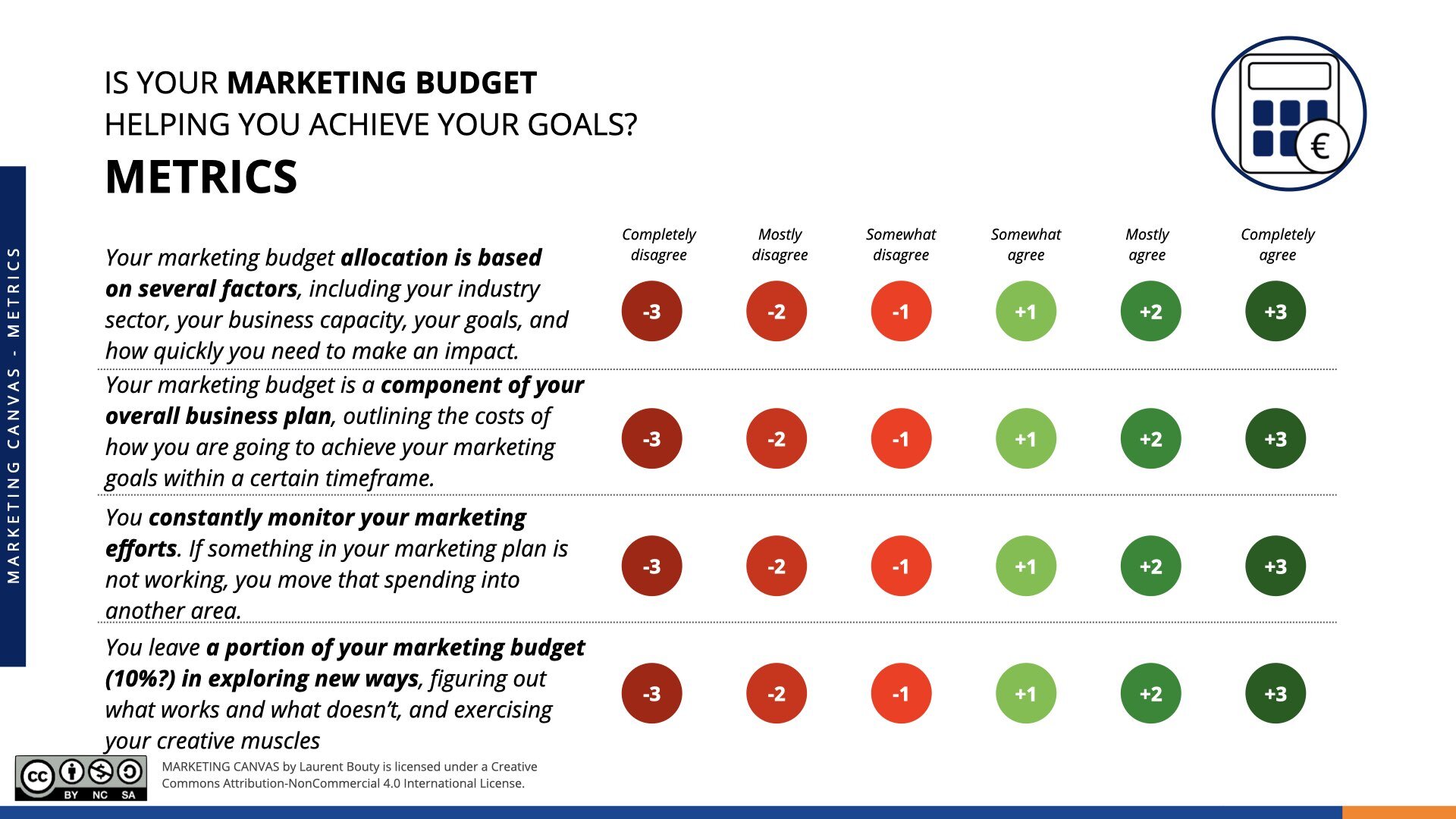Last update: 10/12/2024
In a nutshell
Discover the importance of a well-structured marketing budget in our comprehensive guide. We delve into the critical role of budgeting within the Marketing Canvas method by Laurent Bouty. Learn how to track and manage marketing expenses, whether you're a multinational corporation or a budding startup. Understand the significance of budgeting in terms of industry benchmarks, and discover strategies to spend wisely. Our guide offers practical tools to translate your budget into action, from understanding your audience to tracking expenses effectively. Moreover, learn to evaluate and improve your budgeting practices with our score-based self-assessment. Lastly, get inspired by a real-life example of green clean use case. Whether you're a marketing novice or an entrepreneur seeking new insights, this article offers an essential exploration of the powerful tool that is your marketing budget.
In the Marketing Canvas
The Marketing Canvas is a powerful tool for entrepreneurs and non-marketers to build a robust marketing strategy. It consists of six meta-dimensions, each with four sub-dimensions, for a total of 24 sub-dimensions defining your Marketing Strategy. One of these sub-dimensions is BUDGET, which falls under the METRICS meta-category.
Defining Budget
The Marketing Canvas model proposed by Laurent Bouty offers an in-depth methodology to conceptualize and structure your marketing plan. The fundamental section Bouty underscores is "Metrics," and the sub-dimension "Budget" within it. This sub-dimension serves as a barometer to quantify and keep track of your marketing expenditure, a crucial determinant of your company's marketing efforts' overall success.
The Budget dimension's relevance is ubiquitous, regardless of your company's size. For larger conglomerates, where tracking expenses becomes a standard protocol, marketing becomes an essential cog in the wheel. Conversely, smaller entities like startups or SMEs may not implement such stringent measures, overlooking the importance of earmarking a designated marketing budget, which could potentially hinder growth.
Renowned benchmarks, Gartner and CMOsurvey, offer a broad understanding of how companies, across industries and sizes, allocate their marketing budgets. These benchmarks divulge that, on average, about 11% of the yearly budget is dedicated to marketing expenditure. An alternative way of approaching this is by calculating the ratio between your marketing budget and your revenue. The marketing budget generally represents 6% to 10% of your revenue, a number that can fluctuate depending on your revenue size.
As per the industry suggestions, startups could consider setting aside up to 20% of the anticipated gross revenue for the marketing budget. However, the crucial takeaway here is that it is not solely about allocating funds to marketing, but ensuring that these funds are utilized judiciously. This involves associating your expenses with your actions – if you plan to perform action X to achieve objective Y, how much will Z (the budget) amount to?
Underutilizing your marketing budget can pose problems. It may create a negative impression of your leadership, indicating a lack of execution on planned strategies. Similarly, if your marketing budget falls below the market average, it may indicate under-investment compared to your competitors, acting as an impediment to your business's growth.
A survey by Sortlist conducted in 2021 revealed that the Covid19 pandemic had either positively or negatively impacted the marketing budget for SMBs. On average, the annual budget hovered around a maximum of 10,000€ for 50% of the companies surveyed. However, this figure only accounted for media and content expenses, excluding human resources and platform investments.
Tools for Budget
Having a well-planned budget is a keystone to any successful marketing strategy. However, to implement this successfully, certain tools can provide a great deal of assistance. Software platforms like QuickBooks, Zoho Books, or Sage 50cloud are excellent options for maintaining and tracking your budget. They not only help you keep your budget in check but also ensure the finances are appropriately aligned with your marketing goals.
Spreadsheets can also play a significant role in managing your budget. They provide a straightforward and uncomplicated way to input and track your budget figures. Excel or Google Sheets, with their various functions, can aid in organizing and categorizing your budget.
Moreover, platforms like HubSpot offer a dedicated Marketing Hub that includes budget management tools within their software. This feature enables companies to plan, track, and measure their marketing budgets and ROI from a single platform.
Translating Budget into Action
Translating your budget into action entails strategic decision-making. It involves a deep understanding of your audience and consistent engagement, preparedness for budget variability, consideration of the marketing lifecycle, tracking expenses, and balancing creativity with cost.
For instance, if your target audience is primarily online, then directing a significant portion of your budget to digital marketing would be a wise decision. However, for a local audience, traditional advertising methods, such as billboards or local press, may be more effective.
Maintaining consistency in your marketing approach can result in more significant outcomes than sporadic, high-cost campaigns. This strategy requires planning for sustained engagement with your audience.
Marketing budget needs can change with time. It is vital to remain flexible and adapt your budget based on business needs, market trends, and campaign results.
In marketing, some initiatives, like SEO or content marketing, may take a longer time to deliver results. It's crucial to account for these long-term strategies in your budget, alongside short-term ones.
By using accounting or budgeting software, you can keep an accurate record of your marketing expenditures. This data can provide valuable insights for future budgeting decisions.
While high-cost campaigns may appear more attractive, the most creative ideas are often the most cost-effective. Always seek to balance creativity and budget constraints.
Statements for self-assessment
Is your Marketing Budget helping you achieve your goals?
Evaluating the effectiveness of your marketing budget is a critical step towards its optimization. Here, you assess if your budget is helping you reach your goals.
For a comprehensive evaluation, rate your agreement with the following statements on a scale from -3 (completely disagree) to +3 (completely agree):
Your marketing budget allocation is based on several factors, including your industry sector, your business capacity, your goals, and how quickly you need to make an impact.
Your marketing budget is a component of your overall business plan, outlining the costs of how you are going to achieve your marketing goals within a certain timeframe.
You constantly monitor your marketing efforts. If something in your marketing plan is not working, you move that spending into another area.
You leave a portion of your budget (10%?) in exploring new ways, figuring out what works and what doesn’t, and exercising your creative muscles
Each of these statements evaluates a critical aspect of your marketing budget. Your scores would indicate which areas need improvement, and which areas are effectively managed.
Interpretation of the scores
Negative scores (-1 to -3): Indicate significant gaps in your budgeting process. Resource allocation may lack strategic alignment, monitoring may be insufficient, and there may be little or no investment in innovation.
A score of zero (0): Reflects partial effectiveness. While the budget is functional, it may not be fully aligned with goals, flexible, or innovative enough to drive optimal results.
Positive scores (+1 to +3): Suggest a well-optimized budget strategy. Allocation is strategic, monitoring is robust, and there is a deliberate focus on testing and innovation.
Case Study: Green Clean’s Budget strategy
Misaligned understanding (-3, -2, -1): Green Clean allocates its marketing budget without clear alignment to business goals. The budget lacks flexibility, with no resources reserved for experimentation, leading to stagnation in results.
Surface understanding (0): Green Clean allocates a functional budget aligned with its business plan but struggles to reallocate funds from underperforming initiatives. There is minimal investment in innovation, limiting growth potential.
Deep understanding (+1, +2, +3): Green Clean’s budget is strategically allocated across campaigns, aligned with business goals, and includes 10% for experimentation. Performance is closely monitored, with resources reallocated dynamically to maximize impact.
Conclusion
The Budget sub-dimension emphasizes the importance of strategic allocation, continuous monitoring, and innovation in marketing. A well-structured budget not only aligns with business goals but also ensures flexibility and encourages creative exploration, enabling sustainable growth and competitive differentiation.
Sources
Gartner CMO Spend Survey 2020-2021, Gartner, https://www.gartner.com/en/marketing/research/annual-cmo-spend-survey-research
CMO Survey 2020, Deloitte, pdf, https://www2.deloitte.com/content/dam/Deloitte/us/Documents/CMO/us-cmo-survey-highlights-and-insights-report-feb-2020.pdf
Sortlist, 2021 Marketing Survey: Budgets, Trends and Inspiration for SMBs, https://www.sortlist.com/blog/marketing-survey-smbs-budgets-trends-inspiration/
Medium, 5 Steps to Creating a Small Business Marketing Budget, https://medium.com/@the_manifest/5-steps-to-creating-a-small-business-marketing-budget-2f807065068a




































